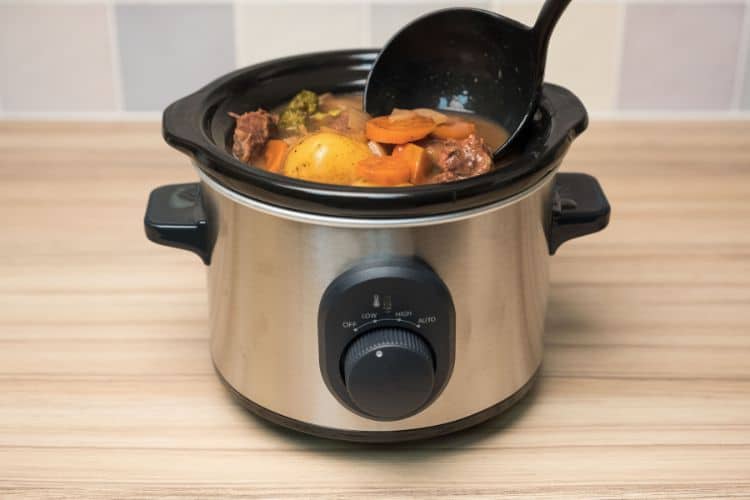I don’t know about you but using the slow cooker in winter is hugely comforting. It’s also perfect for any time of year when you don’t want to have to worry about coming home from work and spending hours in the kitchen. Simply throw everything in before you leave in the morning and when you get back, you’ll have a tasty meal waiting for you.

However, there’s a lot of confusion around the right temperature for a slow cooker. You’ll notice that there are high and low settings as well as a warm option. So, which do you use? How long should it take to cook in a slow cooker? And what’s the difference between the temperature settings on a slow cooker?
In this guide, I’ll cover the answers to these questions so you can confidently use your slow cooker and churn out some delicious, warming meals!
What Is The Best Temperature For A Slow Cooker?
Choosing the right temperature for your slow cooker is important but it would be impossible for me to tell you what that should be. It all depends on the type of food you are cooking because they’re all different.
However, it is important to point out that a slow cooker is primarily designed to cook foods in liquid or that have a high liquid content. One of the most common recipes to cook in your slow cooker is stew. Let’s use this as an example.
When cooking stews or casseroles, you will need to make sure that you bring the liquid to a simmer. This happens when it reaches around 98ºC so you’ll need to have the slow cooker set at least to this temperature.

What’s The Difference Between Slow Cooker Temperatures?
You will notice that your slow cooker typically has three different temperature settings. These are low, high and warm. There are some slow cookers that also have a medium setting but for the purposes of this guide, we’ll keep it simple with just high and low.
The temperature on your slow cooker is changed using a single dial which is one of the reasons that these pieces of equipment are as good as foolproof.
Let’s take a look at what high and low really mean in terms of how hot things get.
High
If you have put your slow cooker on the high setting then you’d expect it to get up to around 149ºC. That said, when you are cooking foods with a lot of liquid, things probably won’t heat up quite as much. You’ll normally find that, once the liquid reaches boiling point, the temperature won’t increase any further.
Low
Your slow cooker’s low setting will normally allow it to reach around 87ºC. This means that food with a lot of liquid will not reach boiling point which is an important factor to keep in mind. Also remember that a slow cooker does exactly what its name suggests; it cooks slowly. Part of this means that the appliance won’t heat up super quick like your stove or oven, instead it takes time and heats up gradually.
Warm
Some, but not all slow cookers will have a warm setting. This is designed to keep already cooked food warm. The food should have been properly cooked above 74ºC but it’s essential to keep in mind that this setting should not be used for cooking food as the temperature isn’t hot enough to kill bacteria and make the food safe for consumption.
So, Does It Make A Difference Which Setting I Use?
If you want to get your liquid to boiling point, then you will need to make sure that the slow cooker is on a setting that will allow this. But that’s really the only important thing to think about when it comes to temperature.
The most important factor to think about when using a slow cooker is how long you leave the food in. It doesn’t really matter whether you are using the high or low setting as long as the timing is right. Also keep in mind that if you use the low setting, it will eventually reach the maximum temperature, it’ll just take longer to get there.
For example, if you use the high setting then it will normally take around three to four hours to get to the max whereas on the low setting, it could take up to eight hours!
Converting Your Slow Cooker Cooking Times
Before we look at how to convert low cooking time to high cooking times, it is useful to understand how long different types of food need to cook. For example, if you’re cooking a piece of fish, this would require a vastly different cooking time to something like a large joint of pork. Below is a table that gives you guidelines on how long different foods take to cook in line with which temperature setting you have chosen.
Type of Meat | Low Cooking Time In Hours | High Cooking Time In Hours |
Large pork joint | 9 ½ | 7 ⅓ |
Pork loin | 6 | 5 |
Medium poultry | 7 ½ | 6 ¼ |
Beef joint | 8 | 5 ¾ |
Stewing meat | 6 | 4 ¾ |
Fish | 3 ½ | 1 ½ |
When it comes to getting the best result, it’s evident that time is the most critical factor. When you use the low setting on your slow cooker, it will typically take almost twice as long to get the same results as it would if you were using the high setting. But as with everything in life, there are a few exceptions to this.
To get the best results, you should follow your chosen recipe. This way, you really can’t go wrong as you’ll have details of which setting to use and how long to cook the food. As with slow cooker operation, it’s pretty foolproof.
However, if you’re creating your own recipes or want to convert the time because you’ll use a different setting, you will need to know how to do this. Short of spending hours calculating in the kitchen, here’s a handy conversion chart.
Low Time In Hours | Divide By | High Time In Hours |
7 | 2.3 | 3 |
8 | 2 | 4 |
9 | 1.8 | 5 |
10 | 1.7 | 6 |
11 | 1.6 | 7 |
12 | 1.5 | 8 |
Tips For Perfect Slow Cooker Results Every Time
As well as knowing just the right amount of time to cook your food and which temperature setting to use, it’s also worth educating yourself on how best to use your slow cooker in general. Below, we have some handy tips to help you make a restaurant worthy meal every time.
Never use frozen meat. If it is frozen, be sure to thaw it before putting it in the slow cooker.
It’s better to use smaller chunks of meat rather than a large joint as these will take less time to cook. That said, it’s more than possible to cook a large joint as long as you’ve got patience.
Start by cooking meat on the high setting for around 60 minutes. After this, switch to the low setting.
Make sure your recipe always contains a liquid. Generally speaking, you’ll want your slow cooker to be at least half filled with liquid.
Never use your slow cooker to reheat food.
Once you’ve turned the slow cooker on, don’t be tempted to keep removing the lid as this will let out precious heat. If you need to check the food, the lid is made from glass so you’ll be able to peer through.
Conclusion
I love cooking with a slow cooker. Things always seem to be so much more tender and delicious not to mention that the house is filled with the aroma of food which is terribly inviting.
However, if you want to produce top notch meals, getting the settings spot on is important. However, what’s more important is leaving the food in for the correct amount of time. You’ll need to adjust this according to which setting you’re using so make sure to check the table further up in this guide.
